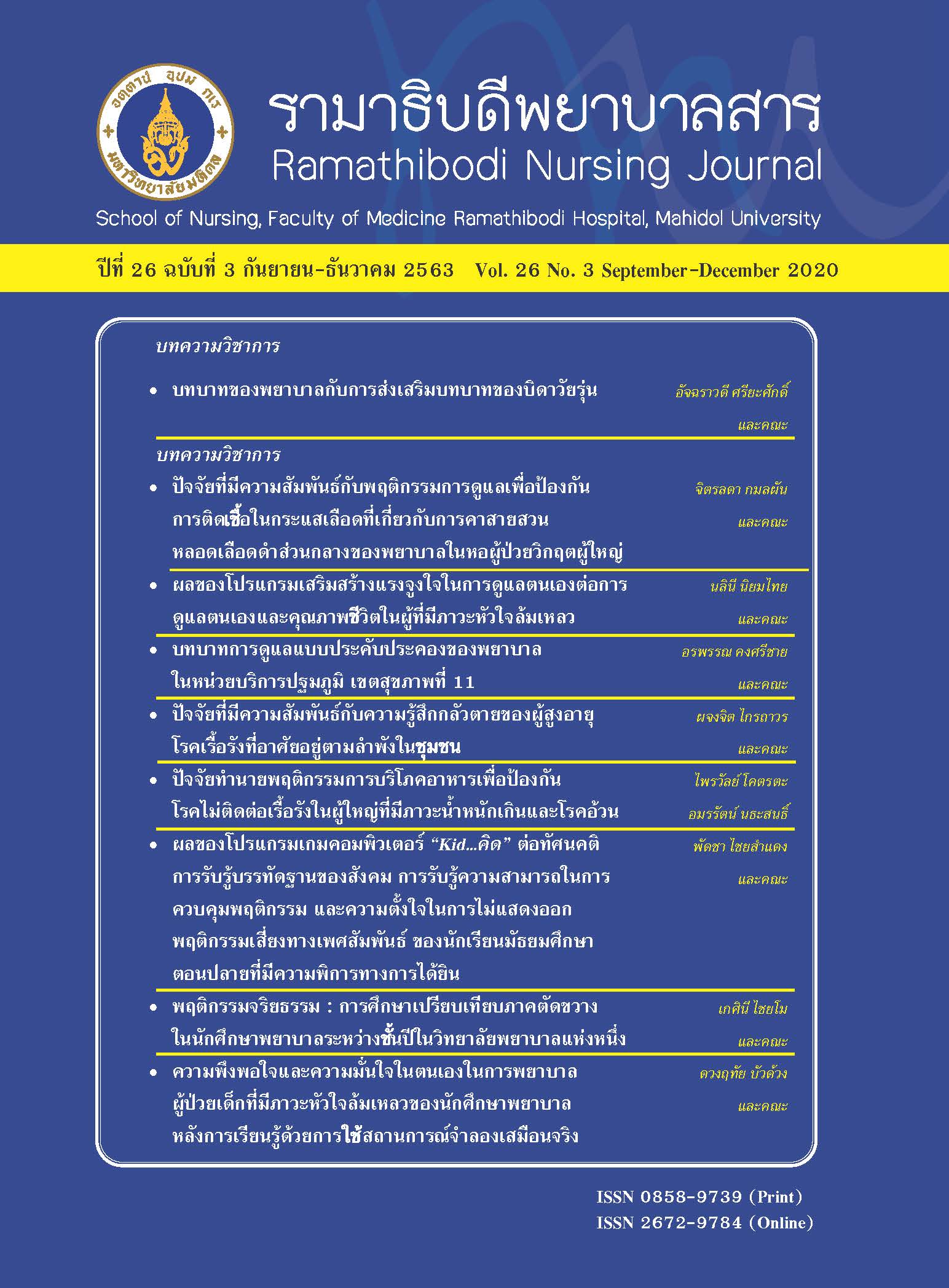Nurses ‘Roles to Promote Teenage fathers' Roles
Main Article Content
Abstract
Nurses play a vital role in taking care of teenage parents starting from the period of mothers’ pregnancy until the childrearing period. Nurses also promote the functions of teenage fathers in the transition to balance their teenage roles and father roles. These help mothers and children receive comprehensive care, both physically and mentally. This article aims to review and present nurses’ roles to promote teenage fathers’participation in taking care of mothers and children and in strengthening the family relationship. Nurses’ roles includes several phases. Firstly, during teenage mothers’ pregnancy, nurses should assess teenage fathers’ feeling towards the wives’ pregnancy,provide specific care for teenage fathers, promote teenage fathers’ roles, promote equality between men and women, and perform a risk assessment of teenage fathers. During delivery, nurses should provide physical and mental support for both mothers and fathers,and promote father-mother-infant bonding. During the postpartum period, nurses should
encourage the fathers to engage in parenting roles, support breastfeeding, and recommend proper contraceptive methods for birth control. During a childrearing period, nurses should encourage fathers’ participation in childrearing and promote a similar pattern of childrearing among family members to prevent any family conflicts.
Keywords: Nurse’s roles, Father’s roles, Teenager
Article Details
บทความ ข้อมูล เนื้อหา รูปภาพ ฯลฯ ที่ได้รับการตีพิมพ์ในรามาธิบดีพยาบาลสาร ถือเป็นลิขสิทธิ์ของวารสาร หากบุคคลหรือหน่วยงานใดต้องการนำทั้งหมดหรือส่วนหนึ่งส่วนใดไปเผยแพร่หรือเพื่อกระทำการใด ใด จะต้องได้รับอนุญาตเป็นลายลักษณ์อักษรจากรามาธิบดีพยาบาลสารก่อนเท่านั้น
References
Department of Health, Ministry of Public Health. Fact sheet 2019 teenage pregnancy situation 2019 [cited 2020
March 31]. Available from: http://rh.anamai.moph.go.th/download/all_file/index/situation/FactSheet@62.
pdf (in Thai)
Chirawatkul S, Rungreangkulkij S, Jong-Udomkarn D,Sawangchareon K, Anusornteerakul S, Wattananukulkiat
S, et al. Prevention and dealing with teenage pregnancy 2011. Coordination Center of the World Health
Organization for Research and Training on Gender and Women’s Health, Khonkaen University. (in Thai)
Pungbangkadee R. Experiences of early motherhood among Thai adolescents: perceiving conflict between needs as a mother and an adolescent. Thai Journal Nursing Research.2008;12:70–82. (in Thai)
Bobak IM, Jensen MD. Maternity and gynecologic care:the nurse and the family (5th ed.). St Louis, MO: Mosby-
Year Book; 1993.
Mercer RT. Becoming a mother: research on maternal identity from rubin to the present. New York: Springer
Publishing; 1995.
Sansiriphan N, Kantaruksa K, Klunklin A, Baosuang C,Jordan P. Thai men becoming a first-time father. Nurs
Health Sci. 2010;12:403–9.
Sriyasak A, Almqvist AL, Sridawruang C, Neamsakul W,Häggström-Nordin E. The new generation of Thai fathers:breadwinners involved in parenting. Am J Men’s Health.2016;23:1-11.
Montgomery KS. Nursing care for pregnant adolescents.JOGNN: clinical issues 2003;32:249-57.
Dallas MC. Interaction between fathers and health care professionals. JOGNN. 2009;38:290-9.
Duvall EM. Family development (4th ed.). Philadelphia,PA: J. B. Lippincott; 1971.
Lamb ME. The role of the father in child development (5thed.). Hoboken, New Jersey: John Wiley & Sons; 2010.
Almqvist A.-L, Dahlgren L. Swedish fathers’ motives for parental leave take-up in different scenarios. In Oinonen E, Repo K. (Eds.), Women, men and children in families:private troubles and public issue (pp. 91-112). Tampere,Finland: Tampere University Press; 2013.
Wilkes L, Mannix J, Jackson D. “I’m going to be a dad”:experiences and expectations of adolescents and young adult expectant fathers. J Clin Nurs. 2011;21:180–8.
Sriyasak A, Almqvist A-L, Sridawruang C, Häggström-Nordin E. Father role: a comparison between teenage and adult first-time fathers in Thailand. Nurs Health Sci.2015;17:377–86.
Promundo, Cultura Saud, REDMAS. Program P. A manual for engaging men in fatherhood, caregiving, maternal and child health. [cited 2020 March 31]. Available from:https://men-care.org/wp-content/uploads/
sites/3/2015/05/Program-P-English-web.pdf
Barker G, Contreras JM, Heilman B, Singh RV. Evolving men: initial results from the International Men and Gender Equality Survey (IMAGES). [cited 2020 March 31].Available from: https://www.icrw.org/wp-content/
uploads/2016/10/Evolving-Men-Initial-Resultsfrom-the-International-Men-and-Gender-Equality-Survey-IMAGES-1.pdf
Royal Thai Government Gazette. Government Gazette 24 January 2012. [cited 2020 March 31]. Available from:
http://www.ratchakitcha.soc.go.th/DATA/PDF/2555/A/090/4.PDF
Department of Health, Ministry of Public Health. National strategies for teenage pregnancy prevention and act for prevention and solution of the adolescent pregnancy problem B.E. 2559 (2016). Bangkok: Cooperative
Federation of Thailand; 2019. (in Thai)
Department of Children and Youth, Ministry of Social Development and Human Security. Guideline for child
support grant. [cited 2020 March 31]. Available from:https://csg.dcy.go.th/ (in Thai)
Sriyasak A, Almqvist AL, Sridawruang C, Häggström-Nordin E. Healthcare providers’ caring for Thai teenage
parents: a focus group study. Midwifery. 2019;69:172-8.
Mamak N, Phumonsakul S, Chareanphol O. Effectiveness of participation of husband program during pregnancy and labour period to marital satisfaction, experience during labour period, and bonding between mother father and child. Ramathibodi Nursing Journal. 2008;14(2):258-73. (in Thai)
Sapkota S, Kobayashi T, Takase M. Husbands’ experiences of supporting their wives during childbirth in Nepal.Midwifery. 2012;28:45-51.
Vajiratanakorn S, Phumonsakul S, Arpanantikul M. The effect of immediately postpartum parents-infant interaction promoting program on mMaternal-infant and paternalinfant attachment of cesarean mothers. Ramathibodi Nursing Journal. 2006;12:(1):94-106.


